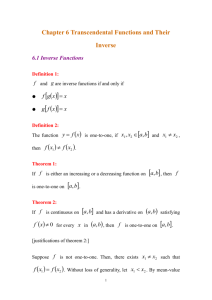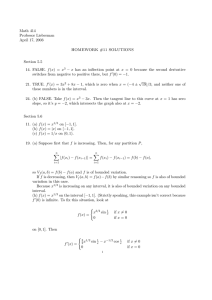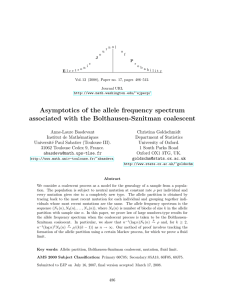Fall 2016, Math 409, Section 502
advertisement
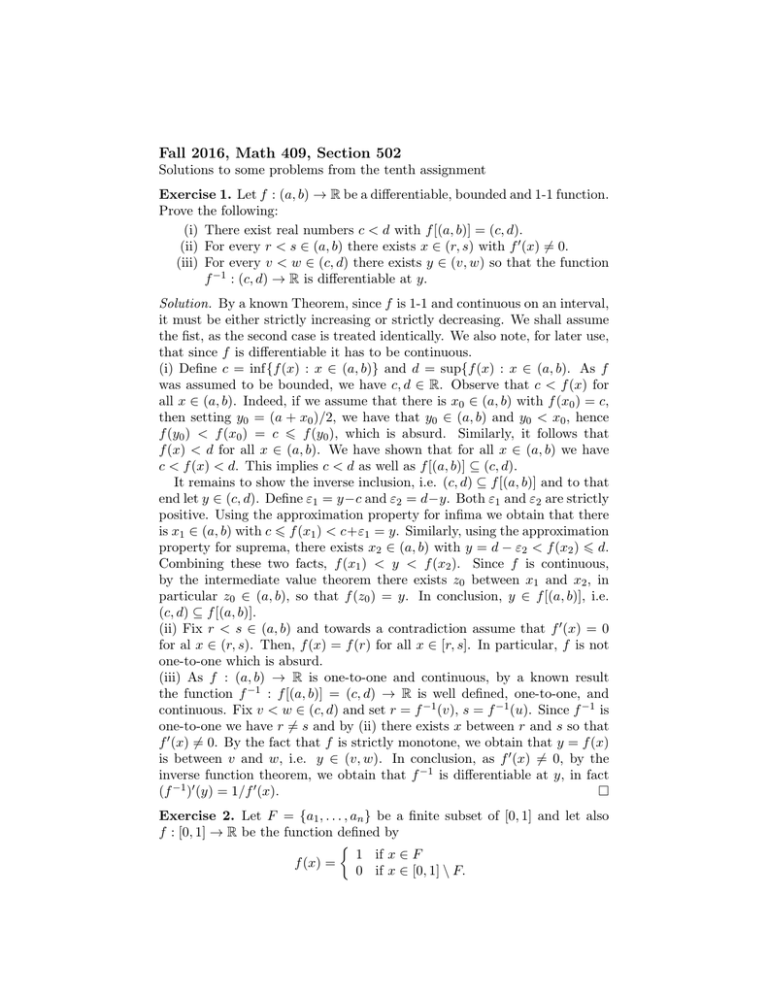
Fall 2016, Math 409, Section 502
Solutions to some problems from the tenth assignment
Exercise 1. Let f : (a, b) → R be a differentiable, bounded and 1-1 function.
Prove the following:
(i) There exist real numbers c < d with f [(a, b)] = (c, d).
(ii) For every r < s ∈ (a, b) there exists x ∈ (r, s) with f 0 (x) 6= 0.
(iii) For every v < w ∈ (c, d) there exists y ∈ (v, w) so that the function
f −1 : (c, d) → R is differentiable at y.
Solution. By a known Theorem, since f is 1-1 and continuous on an interval,
it must be either strictly increasing or strictly decreasing. We shall assume
the fist, as the second case is treated identically. We also note, for later use,
that since f is differentiable it has to be continuous.
(i) Define c = inf{f (x) : x ∈ (a, b)} and d = sup{f (x) : x ∈ (a, b). As f
was assumed to be bounded, we have c, d ∈ R. Observe that c < f (x) for
all x ∈ (a, b). Indeed, if we assume that there is x0 ∈ (a, b) with f (x0 ) = c,
then setting y0 = (a + x0 )/2, we have that y0 ∈ (a, b) and y0 < x0 , hence
f (y0 ) < f (x0 ) = c 6 f (y0 ), which is absurd. Similarly, it follows that
f (x) < d for all x ∈ (a, b). We have shown that for all x ∈ (a, b) we have
c < f (x) < d. This implies c < d as well as f [(a, b)] ⊆ (c, d).
It remains to show the inverse inclusion, i.e. (c, d) ⊆ f [(a, b)] and to that
end let y ∈ (c, d). Define ε1 = y−c and ε2 = d−y. Both ε1 and ε2 are strictly
positive. Using the approximation property for infima we obtain that there
is x1 ∈ (a, b) with c 6 f (x1 ) < c+ε1 = y. Similarly, using the approximation
property for suprema, there exists x2 ∈ (a, b) with y = d − ε2 < f (x2 ) 6 d.
Combining these two facts, f (x1 ) < y < f (x2 ). Since f is continuous,
by the intermediate value theorem there exists z0 between x1 and x2 , in
particular z0 ∈ (a, b), so that f (z0 ) = y. In conclusion, y ∈ f [(a, b)], i.e.
(c, d) ⊆ f [(a, b)].
(ii) Fix r < s ∈ (a, b) and towards a contradiction assume that f 0 (x) = 0
for al x ∈ (r, s). Then, f (x) = f (r) for all x ∈ [r, s]. In particular, f is not
one-to-one which is absurd.
(iii) As f : (a, b) → R is one-to-one and continuous, by a known result
the function f −1 : f [(a, b)] = (c, d) → R is well defined, one-to-one, and
continuous. Fix v < w ∈ (c, d) and set r = f −1 (v), s = f −1 (u). Since f −1 is
one-to-one we have r 6= s and by (ii) there exists x between r and s so that
f 0 (x) 6= 0. By the fact that f is strictly monotone, we obtain that y = f (x)
is between v and w, i.e. y ∈ (v, w). In conclusion, as f 0 (x) 6= 0, by the
inverse function theorem, we obtain that f −1 is differentiable at y, in fact
(f −1 )0 (y) = 1/f 0 (x).
Exercise 2. Let F = {a1 , . . . , an } be a finite subset of [0, 1] and let also
f : [0, 1] → R be the function defined by
1 if x ∈ F
f (x) =
0 if x ∈ [0, 1] \ F.
Use the definition
of the Riemann integral to show that f is Riemann inteR1
grable and 0 f (x)dx = 0.
Solution. We start by observing that if P = {x0 , x1 , . . . , xm } is any partition
of [0, 1], then L(f, P ) = 0. Indeed, since F is finite, for i ∈ {1, . . . , m} the
set [xi−1 , xi ] \ F is non-empty i.e. there exists t ∈ [xi−1 , xi ] with f (t) = 0.
Z 1
f (x)dx = 0.
This yields L(f, P ) = 0 and in extend
0
Similarly, we observe that for any¯partition P of [0, 1] we have 0 6
U (f, P ) 6 1. For arbitrary ε > 0 we will find a partition P of [0, 1] such
Z¯ 1
f (x)dx 6 U (f, P ) < ε and therethat U (f, P ) < ε. This will imply 0 6
0
Z¯ 1
Z 1
f (x)dx = 0, which is the desired result.
f (x)dx =
fore
0
0
To¯ find such a partition, set δ = min{|x − y| : x 6= y ∈ F } and choose any
partition P = {x0 , x1 , . . . , xm } of [0, 1] with kP k < min{δ, ε/n}. The fact
kP k < δ implies that the set E = {1 6 i 6 m : [xi−1 , xi ] ∩ F 6= ∅} has at
most n elements. We calculate
m
X
U (f, P ) =
sup{f (x) : x ∈ [xi−1 , xi ]}(xi − xi−1 )
i=1
=
X
sup{f (x) : x ∈ [xi−1 , xi ]}(xi − xi−1 )
i∈E
X
+
sup{f (x) : x ∈ [xi−1 , xi ]}(xi − xi−1 )
i∈{1,...,m}\E
=
X
X
1 · (xi − xi−1 ) +
i∈E
0 · (xi − xi−1 )
i∈{1,...,m}\E
6(#E)(kP k) 6 n
ε
= ε.
n
Exercise 3. Let f : [a, b] → R be a continuous function with f (x) > 0 for
Rb
all x ∈ [a, b]. If f is not the zero function, show that a f (x)dx > 0.
Solution. If f is not the zero function, there is x0 ∈ [a, b] with f (x0 ) 6= 0, i.e.
f (x0 ) > 0. Since f is continuous, there exists δ > 0 so that f (x) > f (x0 )/2
for all x ∈ [a, b] with |x − x0 | < δ. In particular, there exist a < c < d < b
with f (x) > f (x0 )/2 for all x ∈ [c, d]. Take the partition P = {a, c, d, b}.
Then
Z b
Z b
f (x)dx =
f (x) > L(f, P ) > inf{f (x) : x ∈ [c, d]}(d − c)
a
a
¯
f (x0 )(d − c)
>
> 0.
2
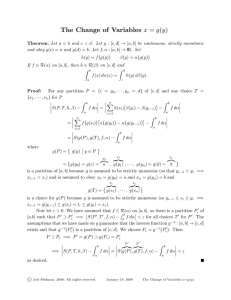

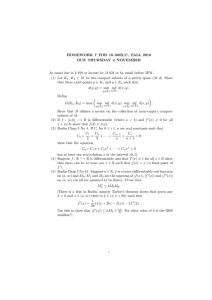
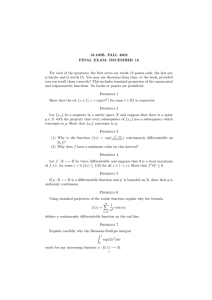


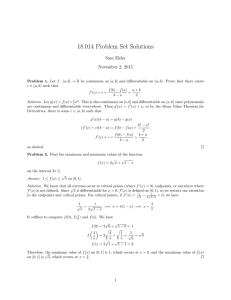
![(1) If f : [0, 1] −→ R is continuous... Z f (x)dx = f (c).](http://s2.studylib.net/store/data/010518093_1-908690675bd939e7f32dbd691b6cbb60-300x300.png)
